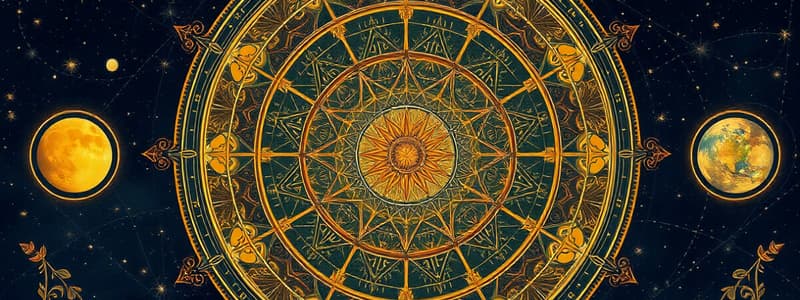Podcast
Questions and Answers
Comets maintain fixed orbits around the Sun.
Comets maintain fixed orbits around the Sun.
False (B)
What is the name of the largest moon in our solar system?
What is the name of the largest moon in our solar system?
- Callisto
- Ganymede (correct)
- Titan
- Europa
The ______ is a vast, spherical region of icy comet nuclei situated the farthest from the Sun.
The ______ is a vast, spherical region of icy comet nuclei situated the farthest from the Sun.
Oort Cloud
Which of these planets is named after the Roman god of war?
Which of these planets is named after the Roman god of war?
What are the two primary types of telescopes used in astronomy?
What are the two primary types of telescopes used in astronomy?
The Sun constitutes about 99.8% of the Solar System's total mass.
The Sun constitutes about 99.8% of the Solar System's total mass.
Match the following planets with their corresponding Greek/Roman deity:
Match the following planets with their corresponding Greek/Roman deity:
What is the name of the closest star to Earth, aside from the Sun?
What is the name of the closest star to Earth, aside from the Sun?
Earth's atmosphere is composed of approximately 78% ______ and 21% oxygen.
Earth's atmosphere is composed of approximately 78% ______ and 21% oxygen.
Which type of supernova occurs during the final stages of massive stars?
Which type of supernova occurs during the final stages of massive stars?
Flashcards
Asteroid Belt
Asteroid Belt
Region between Mars and Jupiter filled with rocky objects.
Kuiper Belt
Kuiper Belt
Extends beyond Neptune's orbit, consisting mostly of icy bodies.
Oort Cloud
Oort Cloud
Spherical region of icy comet nuclei farthest from the Sun.
Ganymede
Ganymede
Signup and view all the flashcards
Solar System Mass
Solar System Mass
Signup and view all the flashcards
Orbital Period
Orbital Period
Signup and view all the flashcards
Largest Volcano on Mars
Largest Volcano on Mars
Signup and view all the flashcards
Names of Planets
Names of Planets
Signup and view all the flashcards
Light Travel Time
Light Travel Time
Signup and view all the flashcards
Proxima Centauri
Proxima Centauri
Signup and view all the flashcards
Study Notes
The Solar System
- The asteroid belt between Mars and Jupiter contains rocky objects.
- The Kuiper Belt, beyond Neptune, is made up of icy bodies.
- The Oort Cloud, farthest from the Sun, is a vast, spherical region of icy comets.
- Comets, composed of dust, rock, and ice, have irregular orbits.
- Ganymede, Jupiter's moon, is the largest moon in the Solar System.
- The Sun is approximately 4.5 billion years old and makes up 98.8% of the solar system's mass.
- Venus and Mercury, closer to the Sun, have shorter orbital periods than Earth and are nearly perfect spheres.
- Mars has the largest volcano in the Solar System.
- All planets except Earth are named after Greek or Roman deities.
- No photograph of the solar system within the Milky Way exists.
Astronomy
- Astronomy uses refractor and reflector telescopes.
- Apollo 11 was the first successful human landing on the Moon.
- Neutron stars and black holes are byproducts of supernovae, the deaths of stars.
- Core-collapse supernovae happen during massive star death; thermal runaway supernovae are another type.
- No probe has yet landed on Jupiter or Saturn.
- The Andromeda Galaxy is a barred spiral galaxy, the nearest major galaxy to the Milky Way, approximately 2.5 million light-years away.
Earth and the Moon
- Earth rotates west to east, and is 150 million kilometres from the Sun.
- Earth's atmosphere is roughly 78% nitrogen and 21% oxygen.
- Sunlight takes about 8 minutes to reach Earth at 300,000 km/s.
- Proxima Centauri is the closest star to Earth besides the Sun.
- The Moon lacks an atmosphere, orbits Earth in 27 days, and reflects sunlight.
- The Moon goes through eight distinct phases.
- A Blue Moon occurs when two full moons appear in a single month (approximately every 2.7 years).
Studying That Suits You
Use AI to generate personalized quizzes and flashcards to suit your learning preferences.





